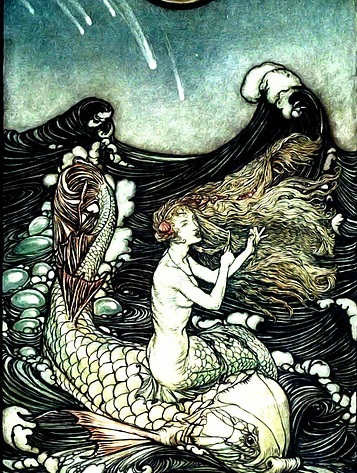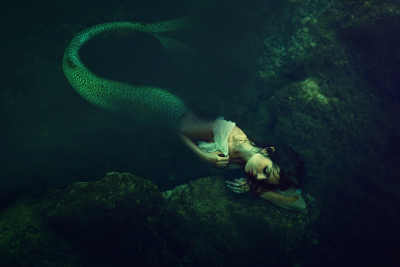
Mermaids are one of a handful of mythical creatures from ancient times that are still talked about today, and even have movies and books still made about them! But is there any truth to the stories of mermaids?
Are mermaids real? Almost every seafaring civilization throughout human history has created legends about mermaids. Despite that, there has never been any substantial evidence that such creatures actually exist.
In this article, you’ll learn what mermaids are, what the US government’s official statement on mermaids is, some logical explanations for the mermaid phenomenon, and more.
What Are Mermaids?
Mermaids are undersea creatures that have the upper body of a human and the lower body of a fish. Most often, we think of mermaids are female. But they also supposedly have male counterparts called mermen. Together, mermaids and mermen are sometimes also referred to as merpeople or merfolk, and it’s assumed they live together.
Cultures from all around the world have their own legends and folklore about mermaids and mermen. If people of a particular area sailed, they usually had some record of encounters with mermaids.
In Greek mythology, Triton, the son of Poseidon, was usually depicted as a merman. During medieval times, mermaids were often blamed for sunken ships or causing severe weather.
In Chinese, Korean, and Japanese culture, the ideas of mermaids go back as far as the 4th Century. Although sometimes their mermaids were depicted a bit differently, as a fish with just a human female head.

Mermaid Hoaxes
Throughout history, various people have presented specimens as examples of real mermaids, but without exception they have all turned out to be hoaxes.
Perhaps the most famous example is P.T. Barnum’s Fiji mermaid.
Most commonly, fake mermaids are made by people who have sewn half a monkey and half a large fish together. Other times, dried out manta rays are presented as mermaids.
What Does The Government Say About Mermaids?
Believe it or not, the US National Oceanic and Atmospheric Administration (NOAA) has actually made an official statement on whether mermaids are real or not.
According to the NOAA, “no evidence of aquatic humanoids has ever been found.” So while they don’t explicitly say it, it’s probably safe to assume that they don’t believe mermaids exist.
However, the NOAA does raise the question of why mermaid stories are so popular among nearly all seafaring peoples. But for now, it doesn’t look like they have an official answer.
However, like many other supernatural creatures like bigfoot or aliens, you may or may not take the word of the government at face value when it comes to mermaids.
Is There A More Logical Explanation For Mermaids?
Various famous captains and sailors throughout history have claimed to have seen mermaids. Even Christopher Columbus mentions seeing them. According to the records of the American Museum of Natural History, Columbus remarked that mermaids he encountered were “not as pretty as they are depicted, for somehow in the face they look like men.”
Nowadays, scientists believe it’s most likely that these early explorers were actually seeing perfectly natural marine creatures like dugongs, manatees, and even dolphins. After weeks at sea, it’s not unreasonable to think that sailors could have seen the vague silhouette of a manatee or similar creature below the water and imagined that it was actually a beautiful woman.
So mermaids might not be real. But what about demons? Read my article Are Demons Real? (What You Should Know About Demons and The Devil) to learn the truth!

Sirens: The Dark Side of Mermaid Legends
The sirens of Greek mythology are often depicted as mermaids. Early on, they were actually seen as half human and half bird most of the time. But somewhere along the line, the story changed and they became half human and half fish.
Regular mermaids are typically portrayed as being neutral or positive toward people. But sirens have a more nefarious intent.
Sirens are believed to sing songs that lure sailors toward rocky coasts or reefs and cause them to crash their ships and sink. Their singing is said to be practically irresistible to any man that hears it, and it’s believed that some sailors even wore earplugs or played their own music so loud they couldn’t hear the sirens, to avoid falling prey to their songs.
Sometimes the sirens are portrayed as beautiful women, while other times they are actually hideous creatures that don’t match their beautiful song, and are just looking to eat humans.
Mermaids and The Lost City of Atlantis
When you hear about the lost city of Atlantis, sometimes people get the idea that it’s actually a city that has always been underwater and is occupied by mermaids. But historically, the city of Atlantis has nothing to do with mermaids.
Instead, the city is believed to have been an actual island in the middle of the Atlantic Ocean and has since sunk into the ocean and disappeared off maps forever.
In Popular Culture
Mermaids and mermen can be found all throughout both ancient and modern cultures.
The most obvious example of a mermaid in modern culture is the 1989 Disney cartoon The Little Mermaid. But mermaids have also appeared in the Harry Potter novels, various fantasy and science fiction literature, comic books, video games, television shows, and more.
If you’re interested in learning about some other supernatural beings, check out my article What Are Poltergeists?

Related Questions
Q: How do mermaids have babies?
A: Since mermaids are half human and half fish, it’s hard to say. If they are mammals like dolphins or whales, then they would give birth to live babies. If they are more like fish, then they would lay eggs. Of course, this is entirely hypothetical.
Q: Can mermaids drown?
A: Marine mammals like whales need to return to the surface to breathe air. Some whales can stay underwater as long as 90 minutes between breaths, while dolphins can only hold their breath for a few minutes. If mermaids are mammals, then they would also need to return to the surface frequently to breathe. If for some reason they couldn’t surface, they could drown. However if they are like fish and can breathe underwater using gills, then they wouldn’t be able to drown.
Q: What do mermaids eat?
A: For what we commonly think of as mermaids, abundant aquatic animals like fish and crabs would be the most logical food choice. However, it’s possible that mermaids could be vegetarian and only eat aquatic plants and algae. For the more evil depictions of mermaids such as sirens, they may particularly enjoy eating the human flesh of sailors.
Q: How long do mermaids live?
A: According to the Danish fairy tale The Little Mermaid (which inspired the Disney movie), mermaids have a lifespan of approximately 300 years.
Conclusion
Are mermaids real? Honestly, it’s very unlikely. But it’s still a fascinating story that has filled the ideas of people all over the world for as long as we’ve been sailing around in boats.
Even if there aren’t real half-fish-half-human creatures out there, it definitely makes for interesting books and movies!
But if we’re honest, only approximately five percent of the ocean has been explored. That leaves 95% of the ocean completely unexplored. We actually know less about the deep sea than we do about the moon. So who knows what’s really waiting out there for us?